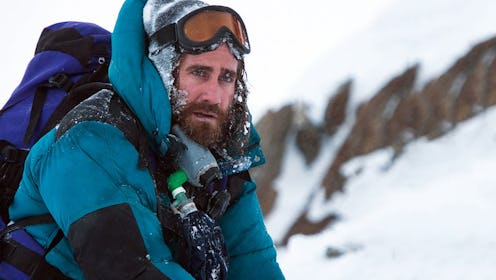
The new film Everest tells the harrowing tale of two groups of hikers climbing the world's tallest mountain with disastrous results. The movie has an insanely star-studded cast including Robin Wright, Keira Knightley, Josh Brolin, and Sam Worthington, with Jake Gyllenhaal portraying the leader of one expedition, and Jason Clarke playing the leader of the other. The hikers get caught up in a storm when they reach the summit, and not all of them make it out alive. It's a scary, gut-wrenching situation for sure, but did it really happen? Is Everest based on a true story?
Unfortunately for those who experienced it, the events depicted in Everest really did happen. In an event known as the 1996 Mount Everest Disaster, eight people died after being caught in a massive blizzard at the summit of the world's tallest point; it was the most fatalities ever recorded on the mountain in a single day at the time. The record would later be broken by an earthquake in 2014 that killed 16 people, and again by another earthquake in 2015. The disaster has inspired multiple documentaries and a number of books, with the most notable being Into Thin Air, which was later adapted into a TV movie. In the newest telling, Everest, Gyllenhaal's character, Scott Fischer, and Clarke's character, Rob Hall, are seen as the actual leaders of the two ill-fated expeditions, and here's what really happened to them.
In case you weren't already aware, Mount Everest is located in the Himalayas, straddling the border between China's Tibet region and Nepal. The mountain rises over 29,000 feet, and the climb is incredibly dangerous, a fact that was never more apparent than on May 10, 1996. On that day, four different expeditions reached the summit of Everest at around the same time, creating a crowded bottleneck situation at the top not often seen (the movie focuses on just two rival teams, Fischer's Mountain Madness and Hall's Adventure Consultants).
Once the teams reached the top of the mountain, their descent was delayed due to the amount of climbers present. This allowed time for a freak blizzard to develop during the descent. Freezing, running out of oxygen, and with snow covering their ropes and trail, the climbers were stuck in quite possibly the worst place on earth. Hall volunteered to stay at the summit with client Doug Hansen, who had completely run out of oxygen. The two were stranded together when Hall radioed for help, and he found it when guide Andy Harris climbed to them solo. But it was too late — Hansen was dead, and soon Harris and Hall lost contact with one another. Both died, but Hall was able to speak to his wife via satellite phone before passing away. His body was eventually recovered, while the bodies of Harris and Hansen have never been found.
Several climbers from both Mountain Madness and Adventure Consultants became lost together and wandered around blindly until midnight when they couldn't walk anymore. Most were later found and were rescued by one of the guides from Mountain Madness, Anatoli Boukreev. Not found until the next day were climbers Beck Weathers and Yasuku Namba. Both were unable to move and were left for dead, and while Namba froze to death, Weathers later regained consciousness and somehow walked back to camp. He was nearly left for dead again the next day before regaining consciousness once more and being helped down the mountain to where he could be airlifted to a hospital. He lost his nose, hand, and parts of his feet, but survived.
Also present was a Taiwanese expedition, led by Gau Ming-Ho. Gau and Fischer became stranded together, and were found by some of the expeditions' Sherpas. They rescued Gau, but left Fischer due to his poor condition and the unlikelihood of his survival. Boukreev soon returned in an attempt to rescue Fischer, but by then he had frozen to death. All of this happened on the mountains south side, but on the north side of the mountain three more climbers also died when they were caught up in the storm, all members of the Indo-Tibetan Border Police.
The Mount Everest Disaster of 1996 remains one of the most tragic climbing expeditions of all time, and is seeing a big budget adaptation for the first time nearly twenty years later in Everest. The movie is sure to be a tearjerker, made even more powerful by the realization of what really happened during that fateful expedition.
Images: Universal Pictures; Giphy (4)